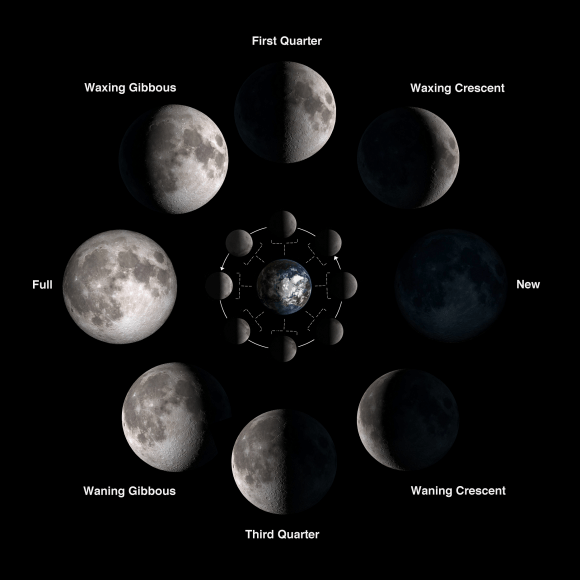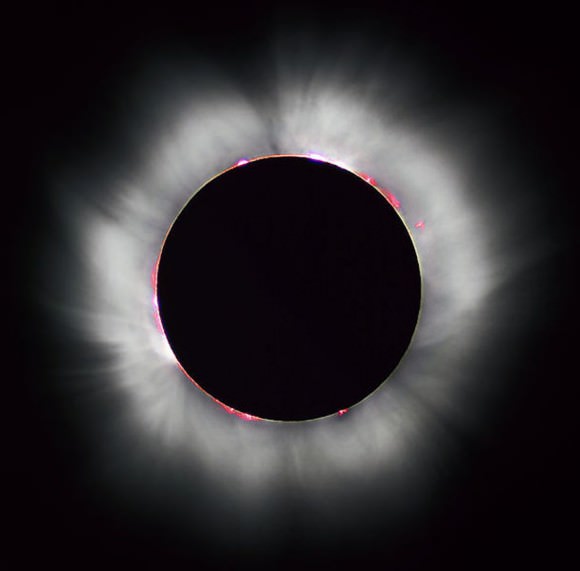What does it mean when you hear the term “gibbous moon”? It’s when the Moon is more than half full, but not quite fully illuminated, when you look at it from the perspective of Earth. The reason the light changes has to do with how the Moon orbits the Earth.
The average distance between the Earth and the Moon is about 382,500 km (237,675 miles). As the Moon orbits our planet, the illumination of the Sun changes on its surface. The Moon takes about 29.5 days to go from a new moon to a full moon and then back again. This is called a “synodic period” or sometimes, a “synodic month.”
It’s slightly longer than the “sidereal period” or “sidereal month” (27.3 days) for the Moon to return to the same position relative to the stars. That’s because the Earth is moving at the same time along its orbit of the Sun, requiring the Moon to “catch up” to reach the same illumination, according to NASA.

So as the Moon orbits the Earth, the illumination of the Sun changes. When the Moon is in between the Earth and the Sun — with the three objects perfectly aligned — the angle between the Moon and the Sun is 0 degrees. This produces a “new moon”, which is when the Moon is not illuminated or barely illuminated at all.
The first quarter occurs when the Moon is at a 90-degree angle with the Sun, as seen from Earth. Once the Moon’s angle exceeds 90 degrees, that’s when it enters the waxing gibbous phase. At 180 degrees from the Sun, the Moon is fully illuminated (a full moon). Then after it reaches 180 degrees, when the Moon and the Sun are on the opposite sides of the Earth, it becomes a waning gibbous moon.
At 270 degrees, the Moon finishes its gibbous phase, enters the third quarter of its synodic period and becomes a waning crescent, until it reaches the new moon phase and starts the cycle anew. And actually, the Moon’s position around the Earth plays a role in solar and lunar eclipses.

A solar eclipse can only happen when the Moon is in its “new phase”. This is, again, because of geometry — because the Moon is in between the Sun and the Earth. From time to time, the position of the Moon lines up with the position of the Sun in Earth’s sky. Coincidentally, the Sun and the Moon appear to be about the same size from Earth’s surface, which makes it possible for the Moon to completely (or almost completely) block the Sun. This creates a solar eclipse. The full eclipse phase can last anywhere from seconds to minutes.
By contrast, a lunar eclipse happens when the Moon is in its “full phase.” At this time, the Earth is in between the Moon and the Sun. When the Moon enters the Earth’s shadow, the shadow can completely or partially fall across the Moon’s surface. A total lunar eclipse phase tends to last anywhere from minutes to over an hour. It creates a ruddy (red or brown) glow due to the effect of sunsets and sunrises all around the Earth shining on the Moon at the same time, according to Bad Astronomy’s Phil Plait.
You’ll notice that as the Moon goes through its various phases, it keeps the same side of itself turned towards Earth. This is due to an effect called tidal locking. After the Moon was formed (likely through a near-cataclysmic collision with Earth), its rotation period didn’t align with that of Earth’s. But over millions of years, the tug of the Earth’s gravity produced a bulge in the Moon’s interior on the side closest to Earth.

As Discovery News explains, over time that bulge was pulled back and forth as the Moon orbited Earth. If the rotation is much slower than the orbit, the bulge “lags behind” while the smaller body orbits. Eventually, this causes one side to always face the larger body.
Tidal locking, by the way, is a fairly common phenomenon in our Solar System — particularly at Jupiter and Saturn, which are massive gas giants that (compared to their immense size) have nat-sized moons orbiting close by. Tidal locking also likely takes place with exoplanets that are orbiting close in to their parent stars.
We have done many stories on Universe Today about the Moon. Here’s one about the phases of the Moon. Want to know when the next full moon is going to be? Here’s a handy guide from NASA that covers the phases of the Moon for 6000 years. And here’s a good explainer on the phases of the Moon. We also discussed the formation of the Moon on Astronomy Cast, Episode 17: Where Did the Moon Come From?


Here’s one from my family. Why don’t recall the first quarter moon a half moon if it is half visible, and half ways from new to full?
I suppose a related question is how long have we known the moon is a sphere? That’s why it is a quarter and is always half illuminated. But how did these terms evolve?